How To Feed Round Hay Bales By Hand
Small square bales of hay don’t have to be the only option on your small farm or homestead! We’ll share how we feed round hay bales by hand without owning a tractor.
Hay Basics
I’ve come a long way from my suburban upbringing where I’m not sure if I could have told you the difference between hay and straw.
So, I full well realize that sometimes it’s helpful to start with the basics.
Hay is simply grass that has been preserved for later consumption. Many livestock graze on pasture during the growing season and then switch to hay during the colder months. Here in northern Illinois, our cows are fed hay roughly November through April each year.

A hay field is cut down, dried out, and then baled up. During the drying period, the cuttings are cured much like a potato is cured when dug up from the garden and goes on to last for months. Cured hay maintains its freshness and nutritional profile when properly stored for at least a year.
The three standard sizes of hay bales and their common dimensions are:
- Small Square Bales – 1.5’ x 1.5’ x 3’
- Round Bales – 4’H x 5’W
- Large Square Bales – 2’ x 2’ x 8’ or 3’ x 3’ x 8’
Small square bales are light and compact enough to be moved by hand. The latter options both require heavy equipment to move. Because of this, many small farms have only ever dealt with small square bales.
But let’s look at some reasons to consider round hay bales.
Why Round Hay Bales Make Sense
When our neighbor who supplies our hay approached me about switching to round bales this past winter, I was skeptical.
However, after trying it for a full winter and assessing the pros and cons, I’m not missing small square bales as much as I thought I would—maybe not at all!
Let’s look at that more in the way of pros and cons of round hay bales.
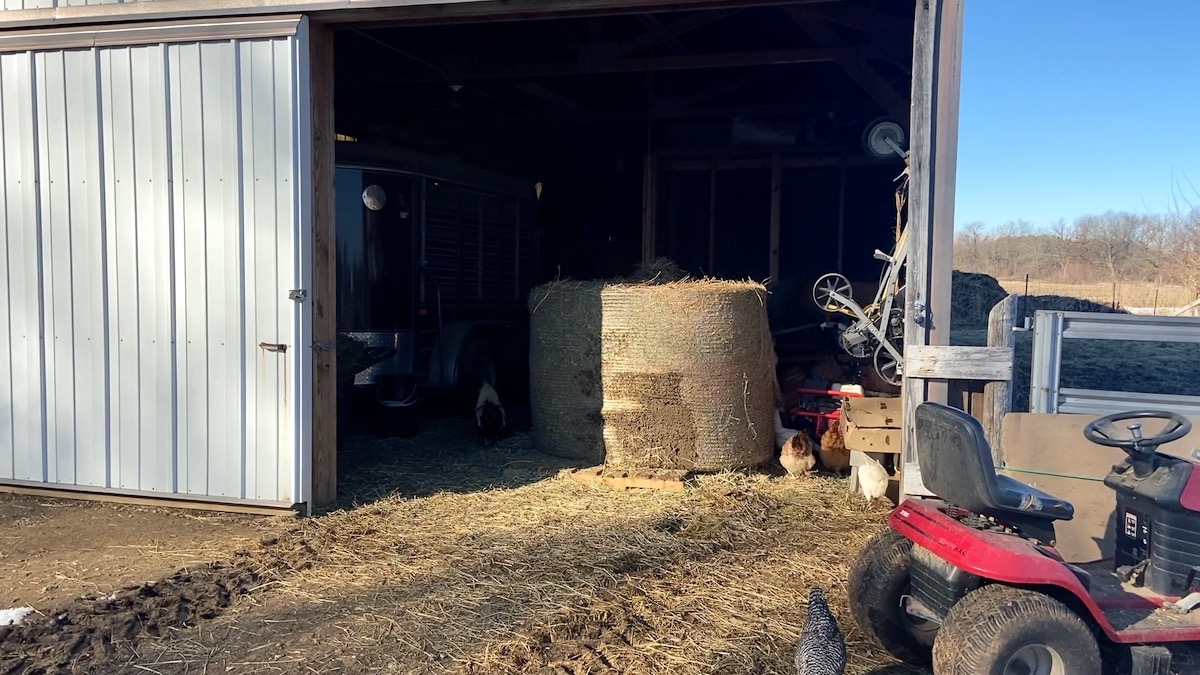
Pros of Round Hay Bales
Cost
Round bales cost less. Pound for pound, you’re buying in bulk and there’s savings to be had there. In our area, a $90 round bale would cost me about $150 in small square bales. Add that up over an entire winter and that’s a lot of savings.
Efficiency
When a farmer has the option to move 1 round bale with a tractor versus 20 small square bales by hand, which do you think they’ll choose? With the right equipment and proximity, exchanging round bales between seller and buyer will save a lot of time.
Availability
Because of this efficiency, many farmers have invested in round hay bale equipment. If you’ve only ever used small square bales before, you might be surprised how many options of round bales are available if you search nearby.
Cons of Round Hay Bales
Moving Them
A standard round bale of hay is going to weigh around 1,000 lbs. You need a tractor or skid steer to move it. And wherever you plop it, it’s not going anywhere. You won’t even nudge it an inch once the tractor leaves—I’ve tried. The good news is that you don’t necessarily need to own the equipment yourself, which we’ll talk more about below!
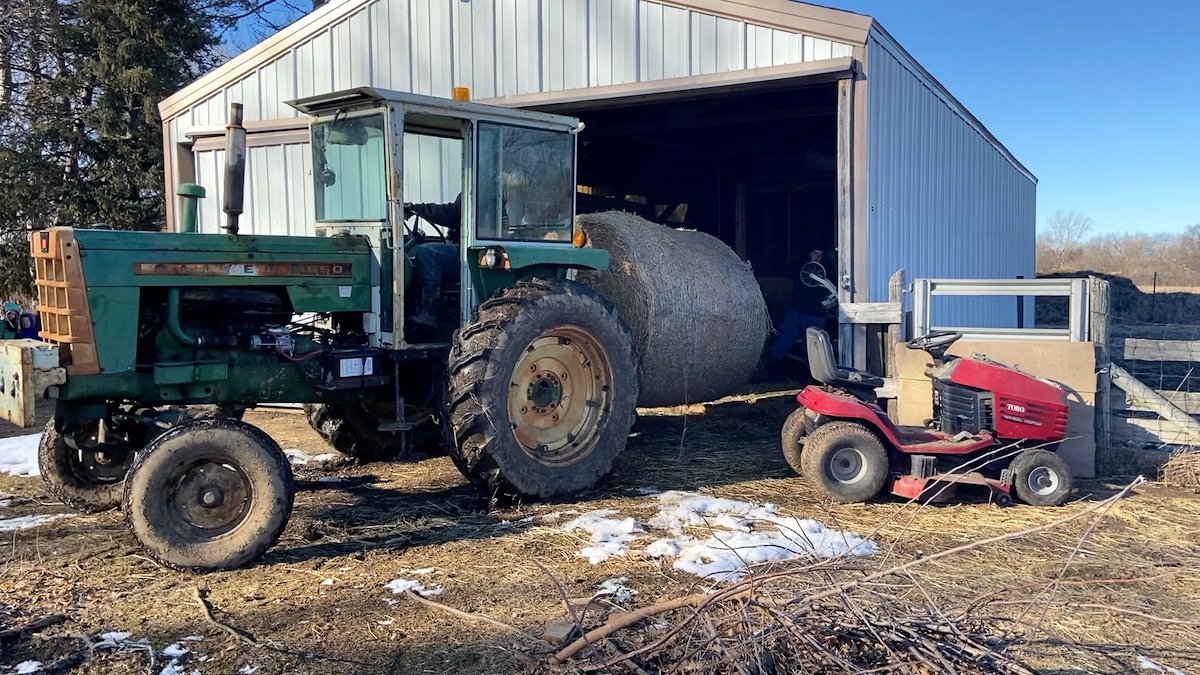
Portioning Them
There’s no getting around it—portioning out the flakes of hay that come off your small square bales is just convenient. With a rolled up round bale it trickier to portion, but not impossible. I share more on how I do that coming up.
Keeping Them Tight
The first few round hay bales I dealt with felt both frustrating and wasteful. Without the right technique, they seem to just keep unraveling and making a mess all over your barn. But again, after learning the ropes this became much more manageable!
Feeding Round Bales of Hay by Hand – Step by Step
To save you some of the frustration and hassle I just mentioned, here is how we’ve made feeding round hay bales by hand work on our small homestead.
Step 1 – Receiving a round bale
We have a small pole barn with an opening large enough for a tractor to back a round bale into (approximately 8’). Assuming you also have a dry and accessible area to fit a round bale into, here are some considerations when receiving a delivery:
- Lay pallets down first. This will raise your bale off the ground so it stays dry. You’ll likely need 4 standard sized pallets for this.
- Have a couple feet of clearance. You’ll need space to efficiently unroll hay for your animals on a daily basis.
- Lay the bale flat side down. This will make working with your bale by hand and unwrapping it easier, which is our next step.
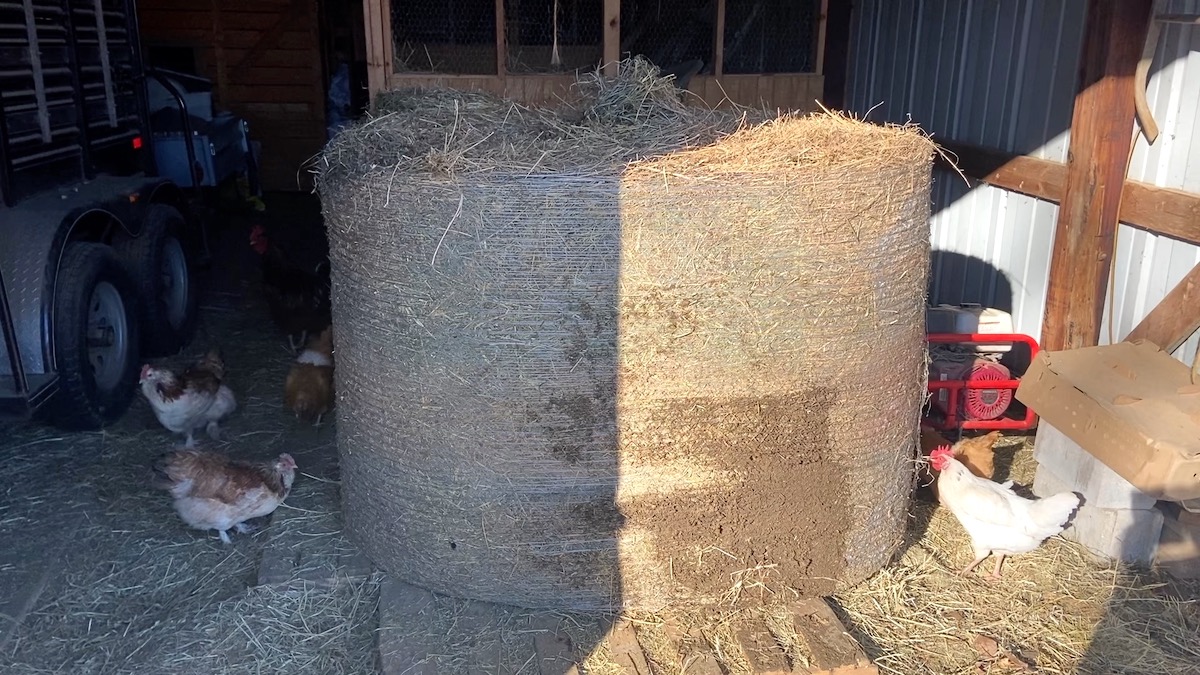
Step 2 – Unwrap your bale
Round hay bales typically have a plastic mesh netting wrapped around them 2-4 times. There’s two ways to remove this wrap.
First is by simply finding the end of it, pulling the netting around the bale, and unwrapping the bale fully. Second is to take a sharp knife or blade and cut through the netting from top to bottom on the bale, and then unwrap it. Both work, but I tend to prefer the first method.
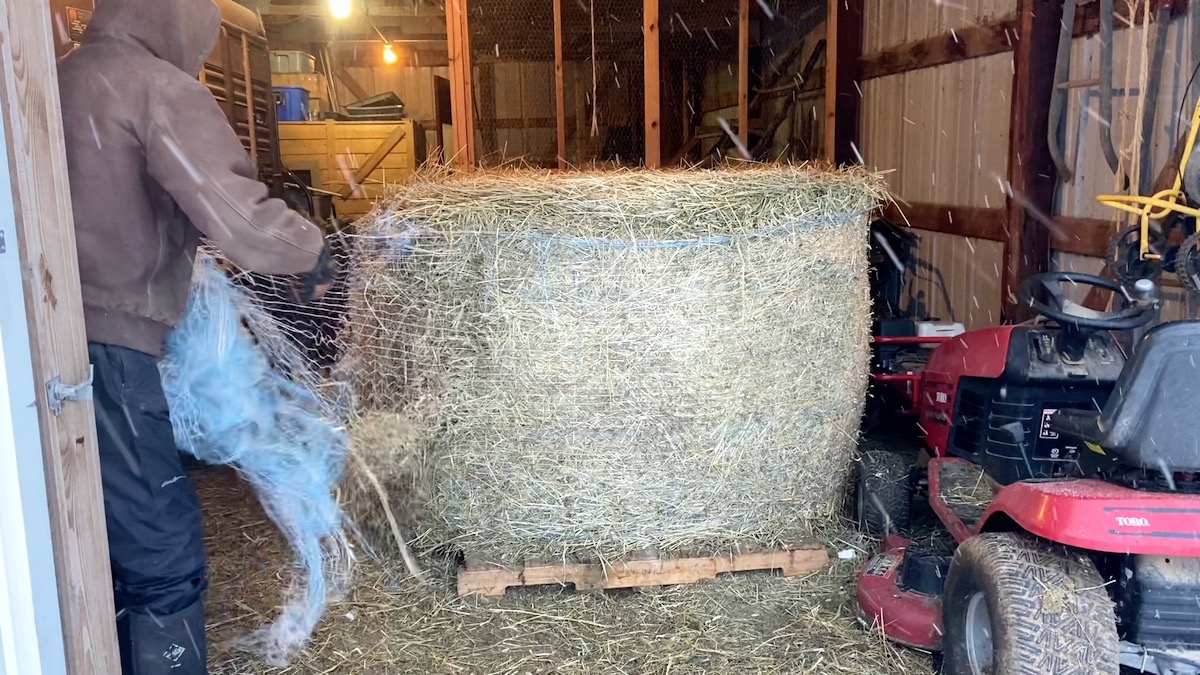
Note that the outside roles of hay may be loose and come unraveled when you first unwrap a round bale. This can be especially dangerous if you have chickens or other small animals that can get trapped by a hay avalanche! Usually, this resolves as you go since the role gets tighter toward the center of the bale.
Step 3 – Unroll flakes of hay
Instead of separating flakes like on a square bale, round bales need to be unrolled. There’s two tricks here I’ve learned to make this easier.
The first is to roll the hay back up as you’re pulling it off and unrolling it. It’s less awkward to keep it in rolled form and work with it that way.
The second trick is how to release the hay you’re unraveling. When you’re done unrolling hay, instead of pulling the hay straight out from the bale, pull it back in the same direction you were rolling from until it releases cleanly.
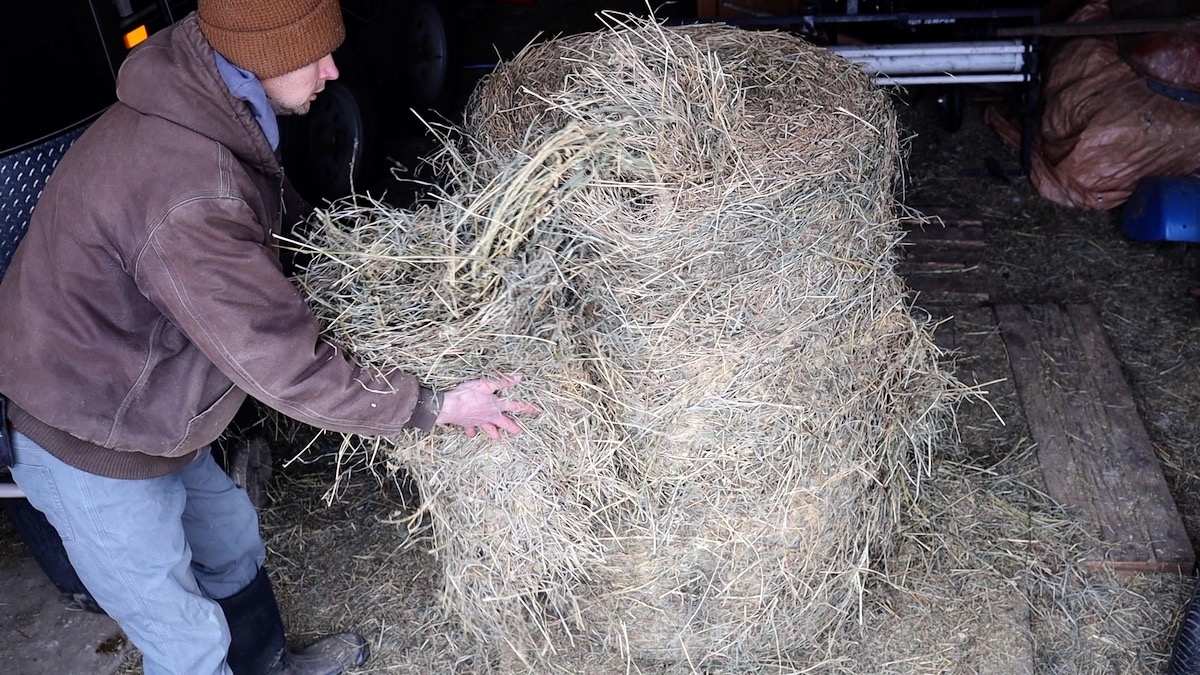
This clean release will help keep the rest of the bale intact. If you don’t do this, the bale will likely continue unraveling and leave you with some extra hay on the ground to clean up.
One more thing worth noting is that a fair amount of hay can fall to the ground while unrolling the bale. Gather this hay up—either by hand or with a rake—and use it. This helps to minimize hay waste.
Step 4 – Feed your animals
If you only need a small quantity of hay at a time, you can likely just unroll some hay by hand and bring it directly to your animals or hay feeder.
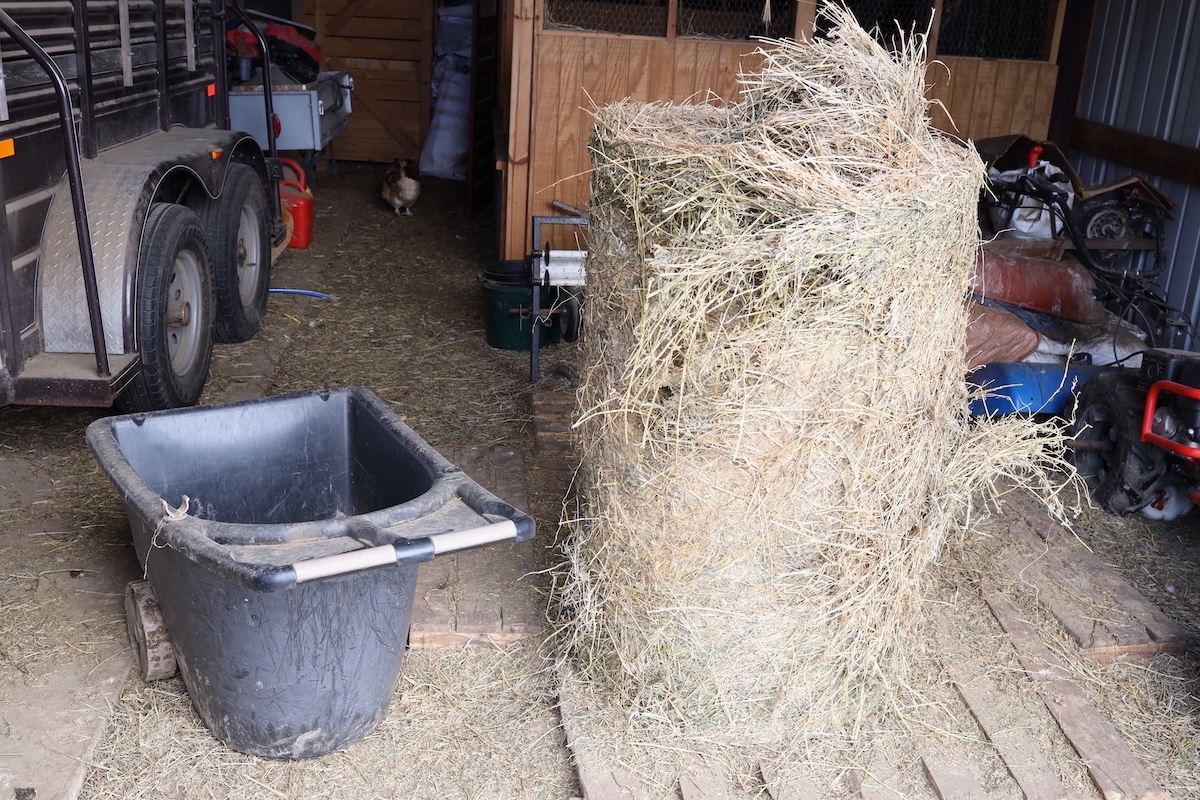
For larger quantities, like when I feed hay to our cows, I’ve found it easiest to have some kind of hay cart or wagon to distribute hay with. I use a plastic garden cart for this and unravel several rolls of hay at a time to fill the cart with. Then I wheel the cart out and dump the hay for them in their paddock.
Step 5 – Getting a replacement hay bale
Once the bale has gotten small enough to relocate, you can clear the space for the next bale of hay to be dropped off.
We’ve found it helpful to keep a careful watch of the weather and be in regular communication with the farmer you’re getting hay from so both sides can plan ahead.
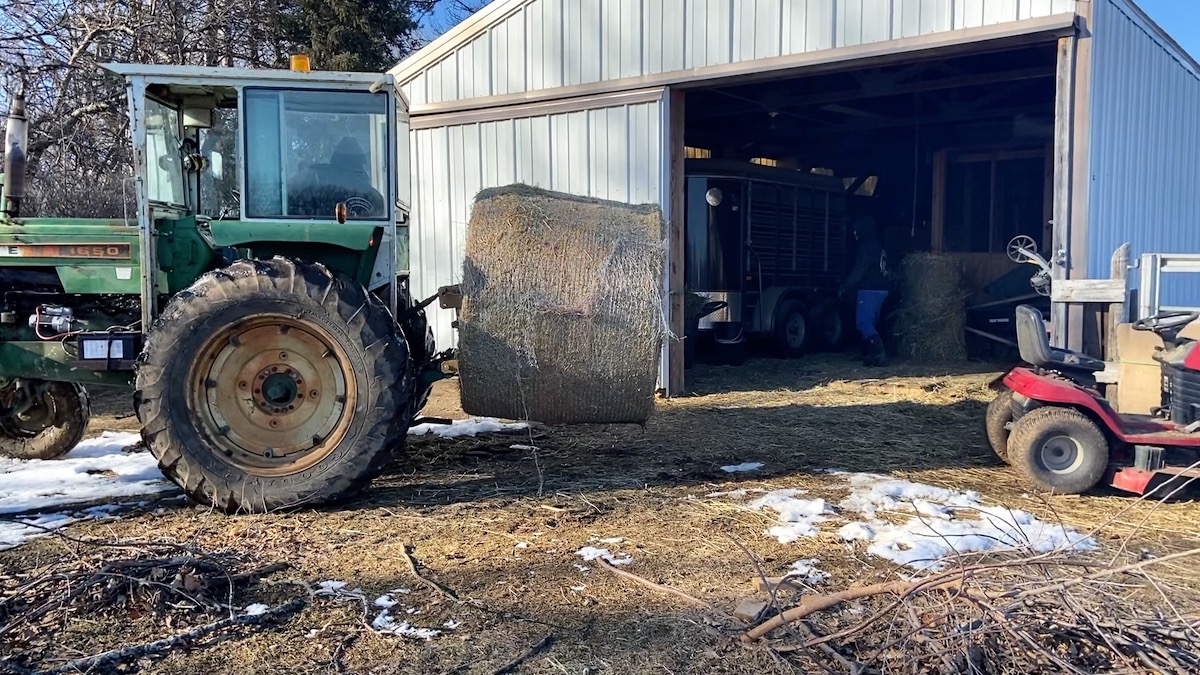
If unfavorable conditions are forecasted like snow, ice, or really cold temps, you may need to expedite things and try to get a bale dropped off sooner so you’re stocked up. Or, if temperatures are going to heat up, you might want to try and get hay delivered before the ground thaws and turns into a muddy mess.
We always try to have a few spare small square bales on hand in case there’s an unforeseen lag period between getting a replacement hay bale.
Round Hay Bales – FAQ’s
Can I use round hay bales if I don’t own a tractor?
Yes! This is very dependent on your farm’s hay intake needs and proximity to sources of hay. But, as we have discovered, it is very possible without owning a tractor or skid steer.
Check with local farms near you to see if they will not only sell you round hay bales, but also be able to deliver them as needed. Even if they charge a delivery fee, it may still be more economical than small squares bales.
And how about that neighbor with a tractor or skid steer? Maybe you can get a few bales delivered and see about borrowing equipment from a neighbor to move them as needed.
With a little creativity and networking, there’s a good chance you’ll find an option that works.

Do you remove netting off round bales when feeding?
Yes. the safest way to feed round bales is to remove the entire netting and dispose of it properly prior to giving it to animals. The plastic mesh netting that wraps a round bale can be dangerous if consumed or an animal gets caught in it.
This post focuses on how to feed round bales by hand. But round bales are also commonly fed in whole form and placed in a field or hay feeder for livestock to consume. In both cases, always remove the plastic wrap first.
How Much Does a Round Bale of Hay Cost?
This will depend both on your location and the quality of hay being purchased. I can speak for our area in northern Illinois, which is pretty representative of the midwest.
High quality, tightly packed round hay bales cost $80-$100. A lesser quality round bale will likely cost $65-$80.
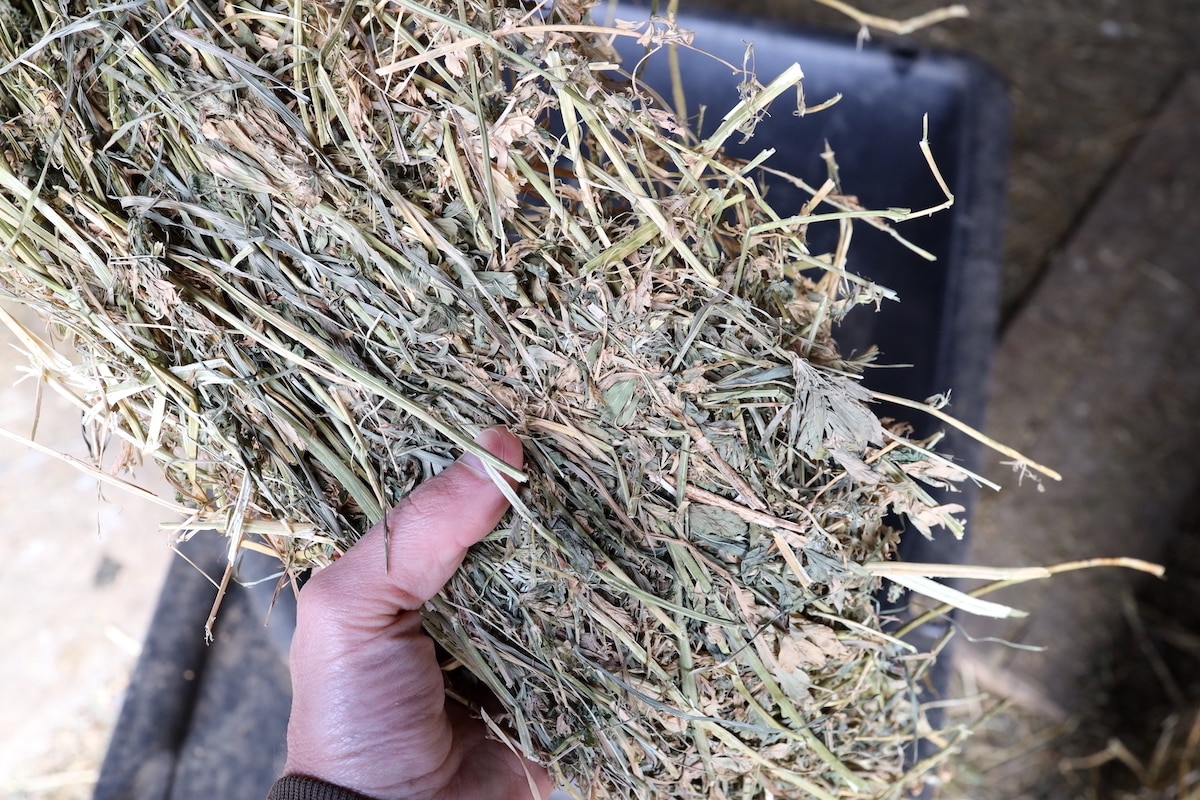
How Much Does a Round Bale of Hay Weigh?
Contents and sizes can vary widely among round bales. A small round bale can weigh as little as 600 lbs. and a large bale as high as 1,600 lbs.
The four standard sizes of round bales are listed below along with their average weight:
- 4’ x 4’ – 600 lbs.
- 4’ x 5’ – 950 lbs.
- 5’ x 5’ – 1,200 lbs.
- 5’ x 6’ – 1,500 lbs.
How Many Square Bales are in a 4×5 Round Bale?
On average, there will be about 19 square bales in a 4×5 round bale.
Small square bales typically weigh between 40-60 lbs. each. If you figure 50 lb. small square bales and a 950 lb. 4×5 round bale, then you would have 19 square bales per round bale.
A 1,500 lb. round bale would be equivalent to 30 square bales at 50 lbs. each.
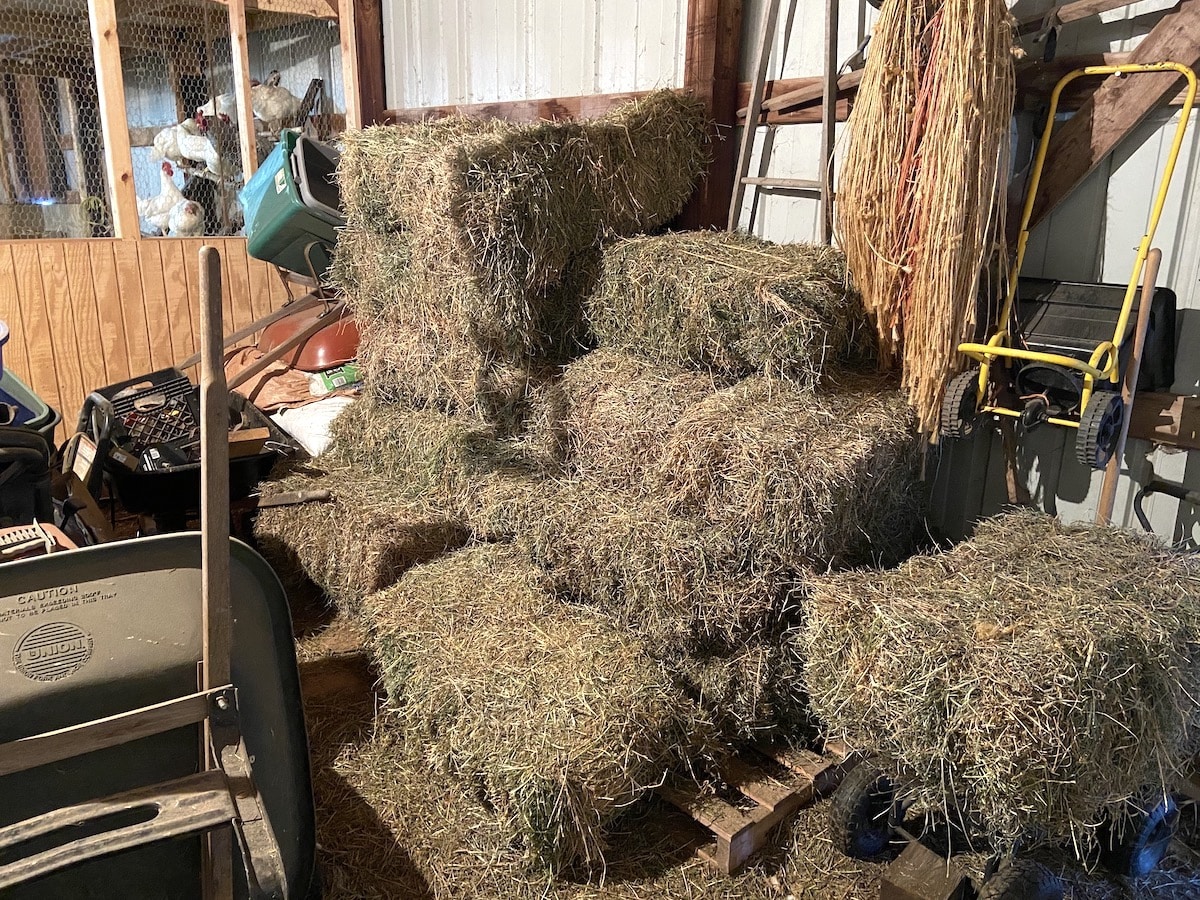
Tips When Purchasing Round Hay Bales
Well grown, cut, and preserved hay is a beautiful thing. It’s sweet smell and freshness is unmistakable.
If you are new to hay and don’t yet have a barometer for high quality hay versus poor quality hay, I’d encourage you to befriend a long-time farmer (preferably one that cuts their own hay) and learn as much from them as you can. Observe some different bales of hay with them and get a feel for what they look for, the smells they notice, the compositions they prefer. That will be your best teacher.
But here are some other things to look for, or to avoid, when purchasing round hay bales.
How To Purchase Round Hay Bales:
- Ask what cutting the hay was from. Farmers typically cut hay three times a season. The 1st cutting is comprised of mainly early season grasses. Your 2nd and 3rd cutting will yield higher percentages of alfalfa and clover. Therefore, later cuttings of hay are typically more desirable.
- Is the bale tightly packed and rolled? A tight bale will contain more hay and therefore be of higher value. Loosely packed bales will also likely lead to more waste.
- Look for hay that has a sweet smell and avoid anything that smells moldy, musty, fermented, or moist.
- It’s normal for the outside of a bale to be discolored, but make sure the majority of the inside contents are green and crisp throughout. Avoid anything that is excessively discolored or bleached beyond the outside layers.
- Look for fine-stemmed grasses and plants and avoid hay that appears fibrous and overgrown.
- Avoid bales that feel warm to the touch or are excessively heavy from moisture. Too much moisture in hay can cause mold or spontaneous combustion.
- Understand the makeup and nutritional profile of the hay. The most common hay mixtures include grasses, clover, and alfalfa. In addition to energy and nutrient rich grasses, alfalfa and clover are high in protein and offer different vitamins and minerals.
- Understand the farmers growing practices and make sure they align with your values. Were synthetic pesticides, herbicides, or fertilizers used? Was the field planted in genetically modified pasture seed?
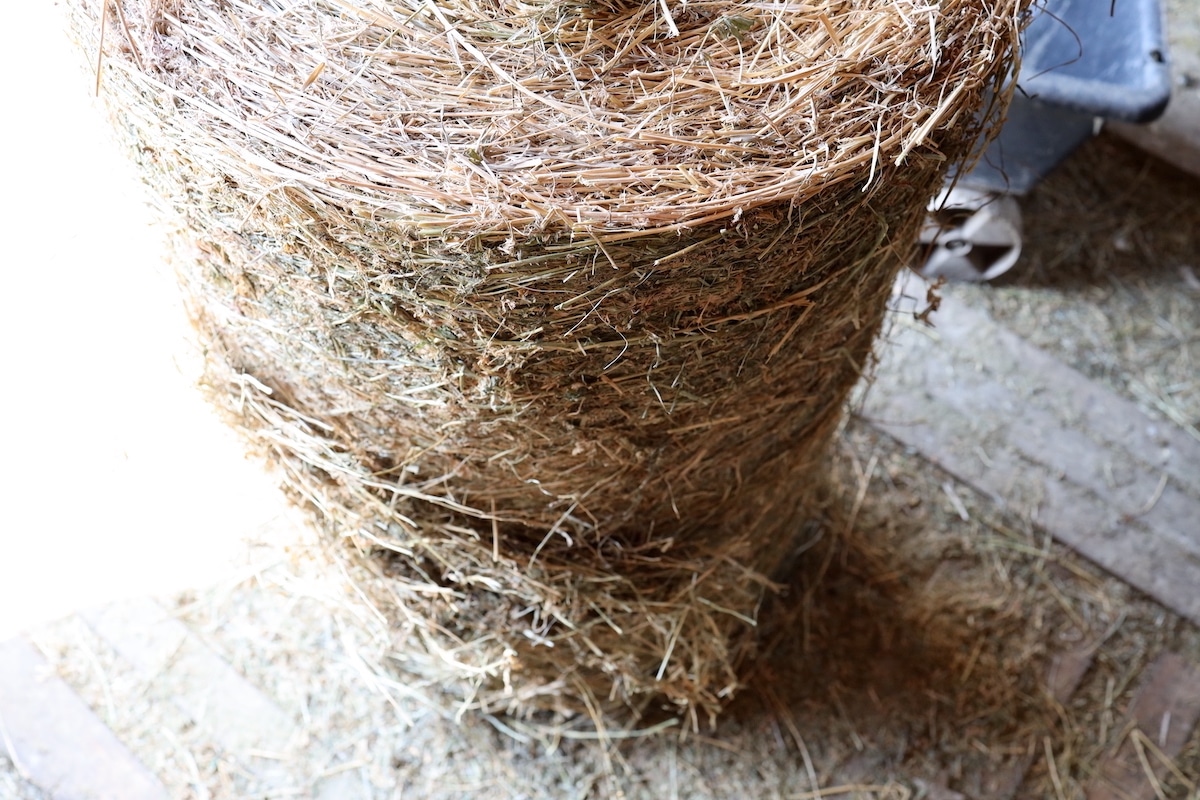
Tips for Reducing Waste When Feeding Round Bales
Round hay bales are commonly fed to animals in whole form—meaning the entire bale is placed in their paddock and consumed over the course of days or weeks.
This is the most convenient way to feed round bales, but also the least efficient. Research has shown as much as 60% of hay can be wasted using this method. The simple addition of a hay feeder can reduce this to only 5% being wasted.
The topic of this discussion, however, has been feeding round bales by hand in smaller quantities. How do you do this and reduce waste?
Our method has been to:
- Dial in the intake amount of your animals
- Dump hay in a different location every day
To get the quantity of hay dialed in, simply start with what seems like a standard amount and observe what happens.
Are your animals showing you signs of being hungry when the next feeding time comes around? If so, increase your quantity.
Is there still hay left that they didn’t eat when the next feeding time comes around? Then try decreasing a bit.
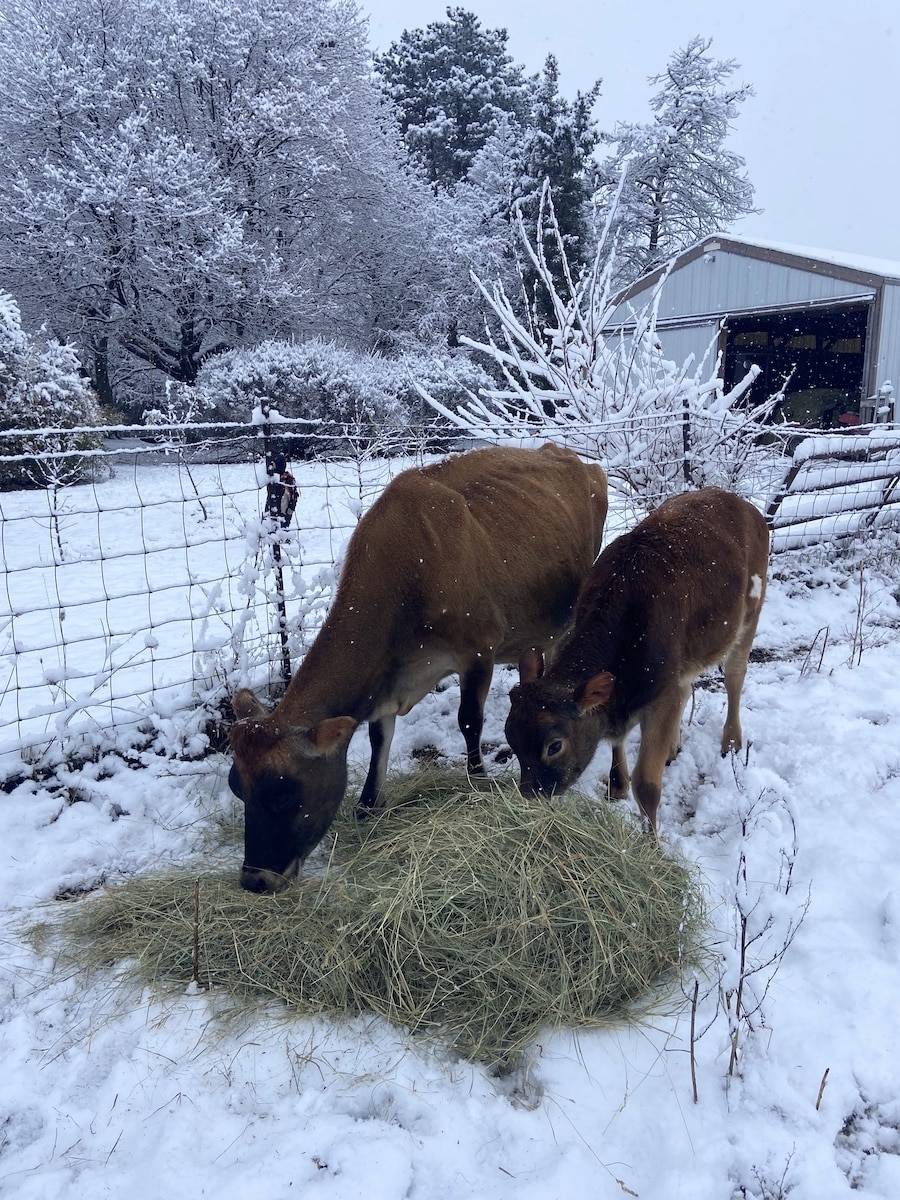
Find the happy medium where your animals are content with minimal hay being wasted. Note that intake needs can change based on variables like temperatures.
Once you have the quantity of hay dialed in, my next method to reduce hay waste is to dump hay in a fresh location at every feeding.
My experience has been that if you feed your animals the right amount of hay in smaller quantities, very little gets wasted. They eat it up before they are able to trample it and poop all over it. Then by the time they’re hungry again, you’re right there with their next round of hay!
For us, this has looked like giving our couple cows one full cart of hay in the morning and one full cart in the evening.
And this leaves us with one final question.
Is a hay feeder necessary when feeding round bales by hand?
Our answer is a resounding—NO!
Could a hay feeder be helpful? Maybe. But it is definitely not a necessity.
We are all about simple homesteading on a budget. Until something becomes an absolute must have on the homestead, we avoid it. This way, we have less things to manage and less expenses.
If you manage your hay situation using the methods I’ve outlined above, I’m willing to bet you can get by without a hay feeder too—whether you use round bales, square bales, or any shape in between 🙂
Related Small Scale Farming Posts:
- How Many Cows Per Acre On A Small Farm
- What To Know About Rotational Grazing On A Small Scale
- Owning a Family Milk Cow Basics
- Why a 5 Acre Homestead is the Perfect Size for a Beginner
- Beginners Guide to Self Sufficient Homesteading
- How To Create A Quarter Acre Self Sufficient Homestead Garden
Pin it for later!
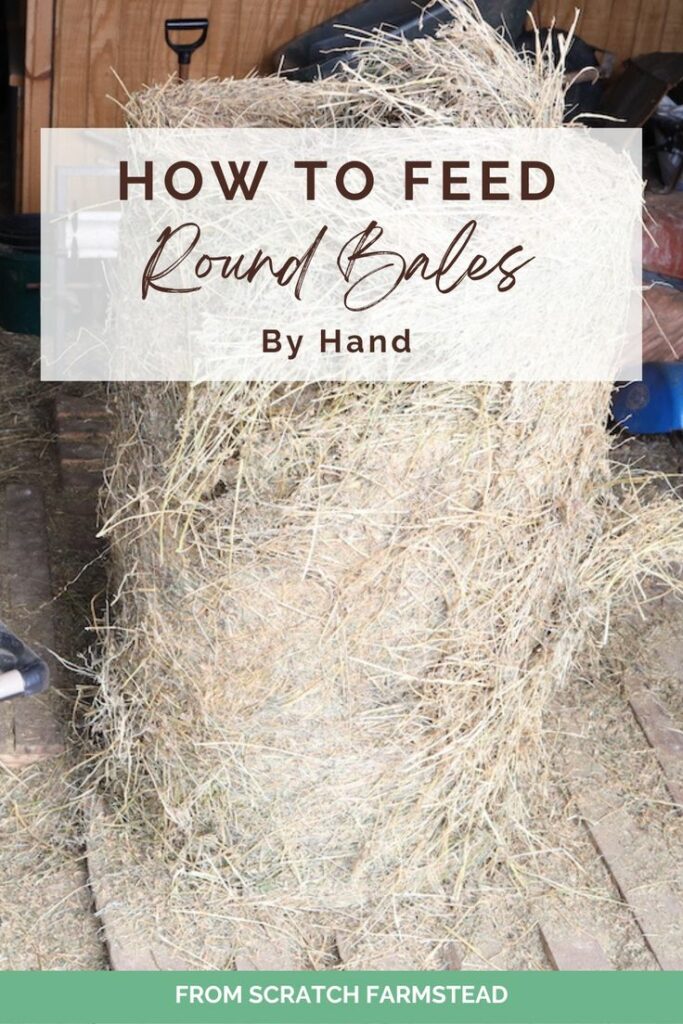

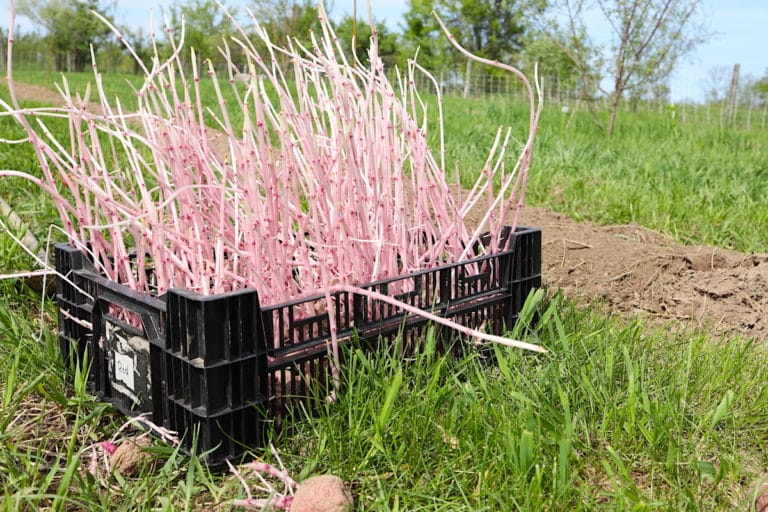
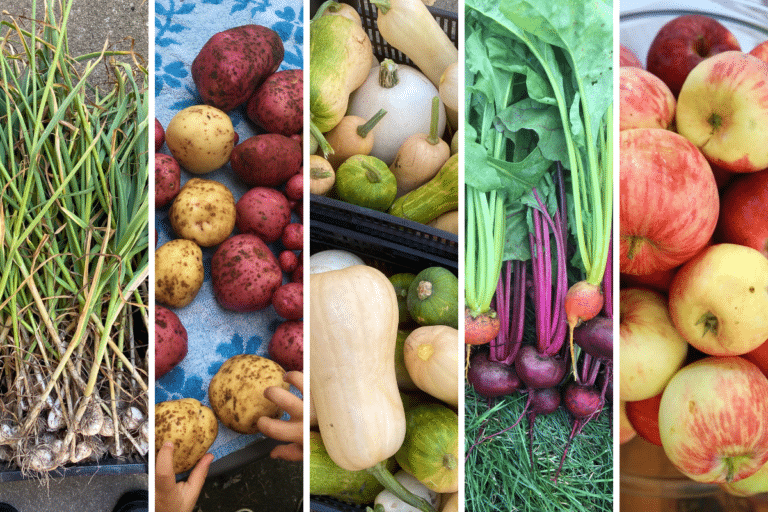
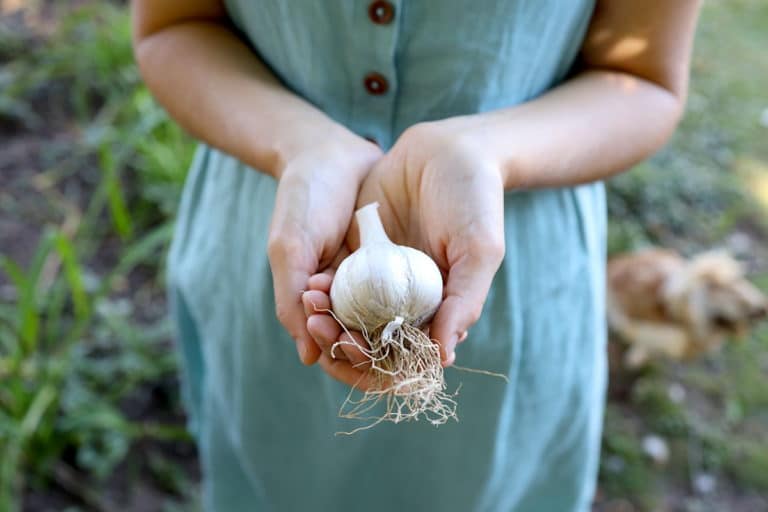
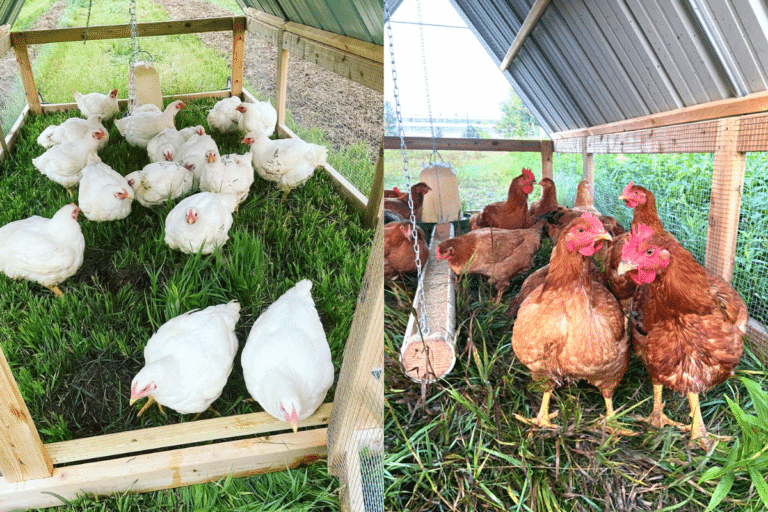

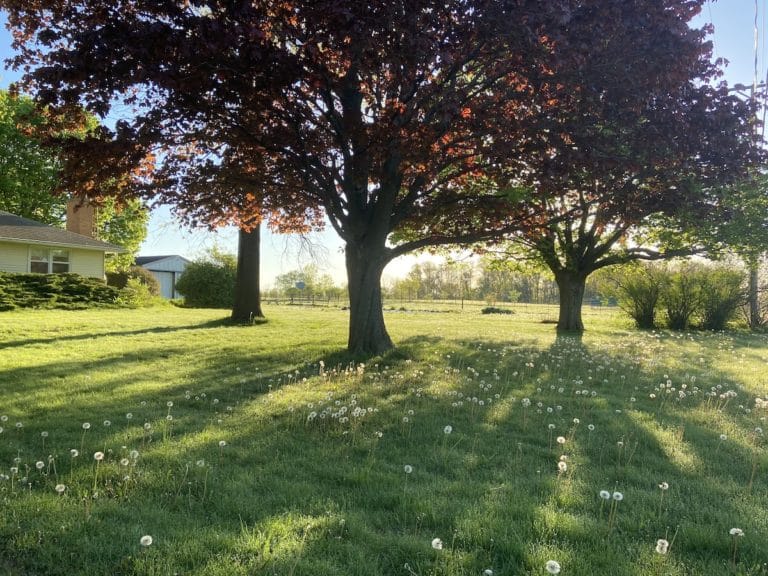
Please give better information for making the Drawing Salve. I have no idea what type or where to purchase the clay and plantain you have mentioned. Charcoal ?
I would like to make this salve.
Hi there! This post has the full instructions and links to the ingredients we use: http://fromscratchfarmstead.com/diy-drawing-salve/. Hope that helps!
This is SO helpful! We decided to go with round bales this winter because of cost but weren’t sure about the logistics. Thanks for sharing your experience!
You’re welcome! So glad this was helpful for you! Hope they work out well for your set up!